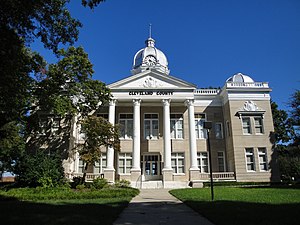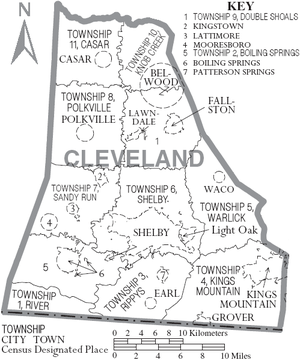Cleveland County, North Carolina
Cleveland County | |
|---|---|
 The west side of the old Cleveland County Courthouse, Shelby | |
 Location within the U.S. state of North Carolina | |
 North Carolina's location within the U.S. | |
| Coordinates: 35°20′N 81°34′W / 35.34°N 81.56°W | |
| Country | |
| State | |
| Founded | 1841 |
| Named for | Colonel Benjamin Cleveland |
| Seat | Shelby |
| Largest city | Shelby |
| Area | |
| • Total | 468 sq mi (1,210 km2) |
| • Land | 464 sq mi (1,200 km2) |
| • Water | 4.0 sq mi (10 km2) 0.9% |
| Population (2010) | |
| • Total | 98,078 |
| • Density | 211/sq mi (81/km2) |
| Time zone | UTC−5 (Eastern) |
| • Summer (DST) | UTC−4 (EDT) |
| Congressional district | 10th |
| Website | www |
Cleveland County is a county located in the western Piedmont and on the southern border of the U.S. state of North Carolina. As of the 2010 census, the population was 98,078.[1] Its county seat is Shelby.[2]
Cleveland County comprises the Shelby, NC Micropolitan Statistical Area. This is included in the Charlotte-Concord, NC-SC Combined Statistical Area. In the late 19th and early 20th century, this was an area of textile mills.
History
The county was formed in 1841 from parts of Lincoln and Rutherford counties. It was named for Benjamin Cleveland, a colonel in the American Revolutionary War, who took part in the Battle of King's Mountain. From 1841 to 1887 "Cleaveland" was the spelling used; the present spelling was adopted in 1887.[3]
Geography
According to the U.S. Census Bureau, the county has a total area of 468 square miles (1,210 km2), of which 464 square miles (1,200 km2) is land and 4.0 square miles (10 km2) (0.9%) is water.[4]
Adjacent counties
- Burke County – north
- Lincoln County – northeast
- Gaston County – east
- York County, South Carolina – southeast
- Cherokee County, South Carolina – south
- Rutherford County – west
Major highways
Demographics
| Census | Pop. | Note | %± |
|---|---|---|---|
| 1850 | 10,396 | — | |
| 1860 | 12,348 | 18.8% | |
| 1870 | 12,696 | 2.8% | |
| 1880 | 16,571 | 30.5% | |
| 1890 | 20,394 | 23.1% | |
| 1900 | 25,078 | 23.0% | |
| 1910 | 29,494 | 17.6% | |
| 1920 | 34,272 | 16.2% | |
| 1930 | 51,914 | 51.5% | |
| 1940 | 58,055 | 11.8% | |
| 1950 | 64,357 | 10.9% | |
| 1960 | 66,048 | 2.6% | |
| 1970 | 72,556 | 9.9% | |
| 1980 | 83,435 | 15.0% | |
| 1990 | 84,714 | 1.5% | |
| 2000 | 96,287 | 13.7% | |
| 2010 | 98,078 | 1.9% | |
| 2015 (est.) | 96,879 | [5] | −1.2% |
| U.S. Decennial Census[6] 1790-1960[7] 1900-1990[8] 1990-2000[9] 2010-2014[1] | |||
As of the census[10] of 2010, there were 98,078 people, 37,046 households, and 27,006 families residing in the county. The population density was 207 people per square mile (80/km²). There were 40,317 housing units at an average density of 87 per square mile (34/km²). The racial makeup of the county was 74% White, 21% Black or African American, 0.15% Native American, 0.69% Asian, 0.01% Pacific Islander, 0.68% from other races, and 0.72% from two or more races. Of any race, 3% of the population were Hispanic or Latino.
There were 37,046 households out of which 32.20% had children under the age of 18 living with them, 55.00% were married couples living together, 13.70% had a female householder with no husband present, and 27.10% were non-families. 23.60% of all households were made up of individuals and 9.60% had someone living alone who was 65 years of age or older. The average household size was 2.53 and the average family size was 2.98.
In the county the population was spread out with 25.20% under the age of 18, 8.80% from 18 to 24, 28.80% from 25 to 44, 23.70% from 45 to 64, and 13.50% who were 65 years of age or older. The median age was 36 years. For every 100 females there were 92.60 males. For every 100 females age 18 and over, there were 88.60 males.
The median income for a household in the county was $35,283, and the median income for a family was $41,733. Males had a median income of $30,882 versus $21,995 for females. The per capita income for the county was $17,395. About 10.10% of families and 13.30% of the population were below the poverty line, including 17.90% of those under age 18 and 14.00% of those age 65 or over.
Law and government
Cleveland County is a member of the Isothermal Planning and Development Commission[11][12] regional council of governments.
Education
Post-secondary
- Ambassador Bible College in Lattimore, North Carolina[13]
- Cleveland Community College
- Gardner-Webb University
Cleveland County Schools
Cleveland County Schools has 29 schools ranging from pre-kindergarten to twelfth grade. Those 29 schools are separated into five high schools, two alternative schools, four middle schools, and four elementary schools.[14][15] It was formed from the 2004 merger of Kings Mountain City Schools, Shelby City Schools and the former Cleveland County Schools.[16][17]
Communities

Cities
- Kings Mountain (part also in Gaston County)
- Shelby
Towns
Census-designated place
Unincorporated community
In popular culture
The 2000 disappearance of Asha Degree, a Shelby girl, was discussed on television shows including America’s Most Wanted, The Oprah Winfrey Show, Good Morning America, and The Montel Williams Show.[18][19]
Parts of the 2012 movie The Hunger Games were filmed in Cleveland County.[20]
Notable people
- Bobby Bell, NFL Hall of Fame inductee
- Alicia Bridges, disco singer
- W. J. Cash, author of The Mind of the South
- Bill Champion, MLB player.[21]
- Morris Davis, Colonel in US Air Force
- Thomas Dixon, Jr., minister, author
- Manny Fernandez, "The Raging Bull", professional wrestler
- David Flair, professional wrestler
- Alvin Gentry, NBA Coach
- Don Gibson, Country Music Hall of Fame inductee
- Kay Hagan, Senator from North Carolina.[22]
- Robert Harrill, The Fort Fisher Hermit
- Keith E. Haynes, Maryland statesman, lawyer
- Norris Hopper, MLB player
- Hatcher Hughes, Pulitzer Prize winner
- Charlie Justice, NFL player, two-time Heisman Trophy runner-up
- Doug Limerick, ABC radio newscaster
- Patty Loveless, country music singer
- Scottie Montgomery, NFL wide receiver, Oakland Raiders, Arena Football League player
- Tim Moore (North Carolina politician), member of the General Assembly since 2003 and elected Speaker of the North Carolina State House in 2015, has lived in the county since 1997 and has his law practice here.
- Travis Padgett, Olympic athlete in Track & Field
- Floyd Patterson, heavyweight boxing champion, Boxing Hall Of Fame inductee
- Rodney Allen Rippy, former child actor
- Earl Scruggs, banjo player and composer, included on Hollywood Walk Of Fame
- Isaac Shelby, soldier, governor
- Charlotte Smith, WNBA basketball player
- Brandon Spikes, professional football linebacker
- Billy Standridge, NASCAR driver
- Tim Steele, 3-time ARCA champion, NASCAR driver
- David Thompson, Hall of Fame college and professional basketball player
- Cliff Washburn, NFL offensive tackle, Houston Texans
- Tim Wilkison, tennis player
- Tom Wright, MLB player.[23]
See also
References
- ^ a b "State & County QuickFacts". United States Census Bureau. Retrieved October 18, 2013.
- ^ "Find a County". National Association of Counties. Archived from the original on 2011-05-31. Retrieved 2011-06-07.
{{cite web}}: Unknown parameter|deadurl=ignored (|url-status=suggested) (help) - ^ "Cleaveland County, North Carolina", Mousely.com, Retrieved 2010-12-30.
- ^ "2010 Census Gazetteer Files". United States Census Bureau. August 22, 2012. Retrieved January 13, 2015.[permanent dead link]
- ^ "County Totals Dataset: Population, Population Change and Estimated Components of Population Change: April 1, 2010 to July 1, 2015". Retrieved July 2, 2016.
- ^ "U.S. Decennial Census". United States Census Bureau. Archived from the original on May 11, 2015. Retrieved January 13, 2015.
{{cite web}}: Unknown parameter|deadurl=ignored (|url-status=suggested) (help) - ^ "Historical Census Browser". University of Virginia Library. Retrieved January 13, 2015.
- ^ Forstall, Richard L., ed. (March 27, 1995). "Population of Counties by Decennial Census: 1900 to 1990". United States Census Bureau. Retrieved January 13, 2015.
- ^ "Census 2000 PHC-T-4. Ranking Tables for Counties: 1990 and 2000" (PDF). United States Census Bureau. April 2, 2001. Retrieved January 13, 2015.
- ^ "American FactFinder". United States Census Bureau. Archived from the original on 2013-09-11. Retrieved 2008-01-31.
{{cite web}}: Unknown parameter|deadurl=ignored (|url-status=suggested) (help) - ^ Isothermal Planning and Development Commission (regional council)
- ^ Isothermal Planning and Development Commission (NC Tomorrow)
- ^ "Contact ABC". Ambassador Bible College. Retrieved September 8, 2012.
- ^ "Cleveland County Schools". NC School Report Cards. North Carolina Department of Public Instruction. Retrieved January 8, 2013.
- ^ "Schools". Cleveland County Schools. Retrieved January 8, 2013.
- ^ "Court affirms school merger approved by the State Board of Education". University of North Carolina School of Government. Summer 2003. Retrieved January 8, 2013.
- ^ "Moore Will Head Merged Schools, Parents Await First Changes to Cleveland County School System". The Charlotte Observer. January 14, 2004. p. 2B.
- ^ [1]
- ^ [2]
- ^ Pickens, Jessica. "Cleveland County, NC, a popular spot for filming movies, TV shows". Halifax Media Group. Retrieved 30 January 2014.
- ^ "Bill Champion's career statistics". baseball-reference.com. Retrieved 2009-03-29.
- ^ "About Kay Hagan". United States Senate. Retrieved 2009-05-12.
- ^ "Tom Wright's career statistics". retrosheet.org. Retrieved 2008-09-08.


